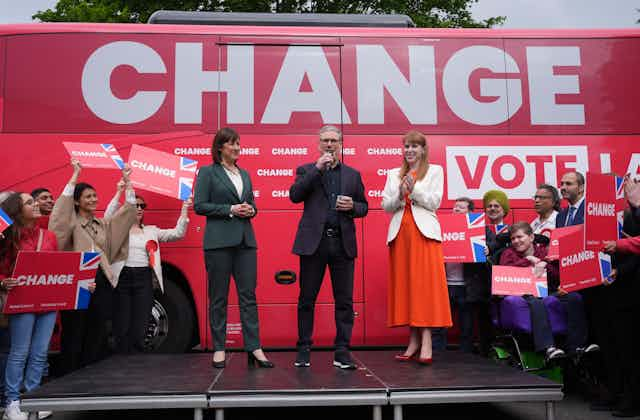With all polls pointing in the same direction, the 2024 election will deliver seismic change. It is being seen as a contest that will practically wipe out one party and deliver a large majority to another. But the reality for most of the voting public will feel quite different, at least at the constituency level.
The Electoral Reform Society has estimated that more than 100 of the UK’s 650 parliamentary seats haven’t changed hands for 100 years or more. Millions of voters, therefore, reside in what the society describes as “one party fiefdoms”.
The data shows that 28% of constituencies have been held by the same party since the second world war, and that 38% have remained under the same party’s control for 50 years or more. The Conservatives dominate in 94 of the seats which have not changed hands for over a century; Labour holds 17 of them.
Prior to the dissolution of parliament last month, Labour held over 200 seats. It is highly likely that very nearly all of these seats will return a Labour MP again.
Meanwhile, opinion polls have suggested that the Conservatives are currently on track to win between 66 and 140 seats. These “wins” are more than likely going to be seats the party already currently holds.
Strong polling trends also indicate that the Liberal Democrats will retain the 12 seats they won in 2019 and any SNP seats are likely to be among the 48 they won in 2019.
Given these figures, it is not difficult to see how almost half the seats are likely to be represented by the same political party as before the election was called.
When is a marginal not really marginal?
Even though 13 parties were represented in the Westminster parliament when it was dissolved for this election, and even though many more parties will be listed on ballot papers, barely any constituencies are truly what can be considered multi-party contests.
Under first-past-the-post, the majoritarian electoral system used for British general elections, voters’ choices are limited at the ballot box.
Sometimes that’s because not every party is standing in their constituency – for example, the SNP only stands in Scottish seats, Labour doesn’t stand in Northern Ireland, and the Greens are concentrating on target seats in 2024. More often though, the limitations are indirect – voters appear to have a choice between many parties, but only one or two have a realistic chance of winning.

Want more election coverage from The Conversation’s academic experts? Over the coming weeks, we’ll bring you informed analysis of developments in the campaign and we’ll fact check the claims being made.
Sign up for our new, weekly election newsletter, delivered every Friday throughout the campaign and beyond.
For too many people in the UK, voting is not a true choice between parties. Thanks to the first-past-the-post voting system, much of the electorate resides and votes in safe seats – constituencies where certain parties have consistently and repeatedly won with quite substantial majorities. Even so-called “marginal constituencies” are often contests between no more than two parties; the one defending it and the one most able to replace the incumbent.
In these circumstances, voters can feel cornered into tactical voting, supporting a viable party in their local constituency to defeat a party that they dislike, rather than casting a vote for the party they genuinely prefer.
2019’s record
In 2019, in what was described as an “earthquake” election which gave the Conservatives the largest parliamentary majority since Tony Blair in 2001, just 81 seats (12.5%) changed hands. Only 37 seats – 5.7% of all those contested – were three-way marginal races in which the vote-share gap between first and third place parties was less than 20 percentage points. Ynys Mon was the closest, where just 7% separated the Conservatives, who won the seat, and Plaid Cymru, who came third behind Labour.

Most true electoral battles are concentrated in a few highly competitive areas, leading parties to focus their resources on these seats. In 2019, the overwhelming majority of seats saw just two parties hold a realistic chance of winning – and 100 of them had a two-party vote share of over 90%.
If we exclude the five constituencies where an independent candidate came second (no independent won any seats) and the Speaker’s seat (which is traditionally uncontested by the other main parties), the average vote share of the top two parties in the remaining 644 constituencies amounted to 83.67%. Only 158 had a two-party vote share of less than 80%, meaning that, at best, the third-place candidate in each of these seats, received half the votes of the winner. If that sounds like an unwinnable seat, it’s because it probably is.
The number of very safe seats – seats won by a margin of between 45 and 50% – increased from 29 to 31. Of the 30 safest seats, Labour holds 20 and the Conservatives ten.
None of this means that change cannot happen, and shocks do occur at a local level. But drastic changes are generally limited to a small number of constituencies. Even in Tony Blair’s landslide election victory in 1997, less than a third of seats (181 out of 650) changed hands.
Many voters will feel bypassed in this election, as they often do. This perhaps helps explain why, despite talk of a seismic shock at the national level, there seems to be a very low level of enthusiasm for this election and the people running in it.

